15 Interesting Facts about Christopher Columbus
When it comes to selecting the most influential persons in history, the
choice is vast. Christopher Columbus is certainly one of the most notable
characters, as his "discovery" of what is now known as the Americas had
profound consequences on history, and kick started the era of European colonization. Born in the Republic of Genoa, sometime
before October 31, 1451, the Italian explorer had a storied life full of
achievements and downfalls.
First Landing of Columbus on the Shores of the New World -
Painting By San Salvador (1862)
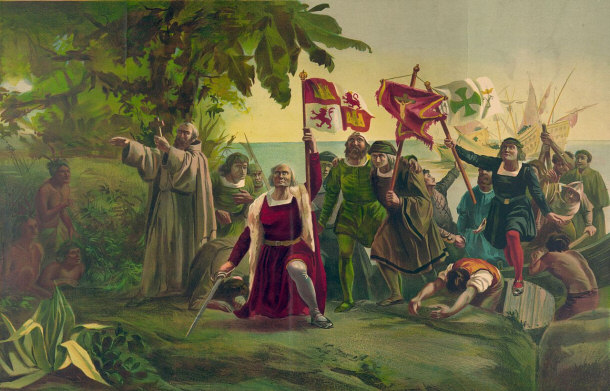
One of the most interesting things to note about
Columbus is that the popular image of the explorer differs from the actual
character. The reasons for this are numerous, mostly stemming from his
popularity in culture as the discoverer of the New World and the grandfather of
the Americas as we know them. Here are 15 fascinating facts about Christopher
Columbus and his life.
15) His Origins are a Matter of Debate
With Christopher Columbus' prominence, one can assume that nearly everything
about his life is known. One particular thing about his life that stands out is
that question of his origin. The most commonly accepted hypothesis, supported by
Genoese documents, is that he was born in Genoa Italy, to a lower-middle-class
family. However, several other theories have also been proposed. Many of them seek to
reconcile certain facts from his life with a seemingly incompatible beginning.
For instance, as a man from the lower middle class, Columbus would not be
permitted to marry a woman from the noble class in Spain. And yet he did.
Another reason his origin is debated is the question of language. Columbus wrote
predominantly in Spanish, with the exception of a handful of notes and glosses
in Genoese and Italian present in books he owned.

Alternative theories of Columbus' heritage include him being of Cataln
descent, mostly based on linguistic investigations, because he referred to
himself consistently as Christobal Colom. Other proposals suggest he was
descended from Byzantine Greek nobility, from the Spanish-Jewish community, and
even that he was the son of Polish King Wladyslaw III, who survived the battle
of Warna in 1444.
14) Columbus was Almost Rejected
It's easy to say that the expedition was profitable in hindsight, but in
the 15th century people were skeptical of Columbus' plans to discover a western
sea route to Japan, China, and India. The explorer first presented his plans to
the Portuguese King in 1485, asking for three seafaring ships, the title of
Admiral, and 10 percent from all commercial revenue from the trade routes he
would plot. His plans were rejected, not because of Columbus' price, but because
the proposed plan was considered to be unfeasible by royal experts. Undaunted,
Columbus attempted to convince the King again three years later. He was denied,
as the eastern route to Asia was within grasp with Bartholomew Dias' successful
navigation around Africa.
Columbus Showing His Projects to Salamanca Council
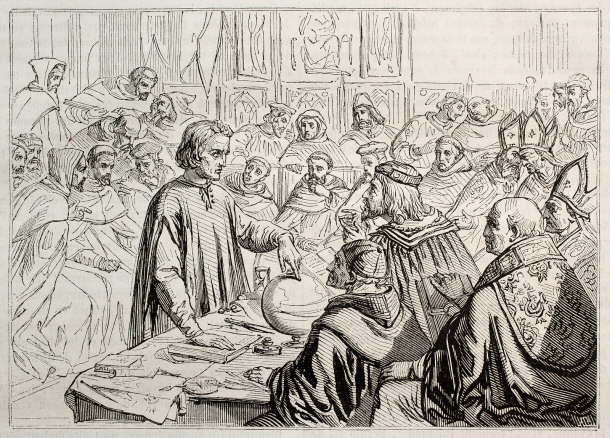
Columbus turned his sights to the merchant republics of Genoa and Venice,
again to no success. Likewise, his brother's mission to the English King, Henry
VII, was unsuccessful. Ultimately, Columbus would find funding and support at
the court of Spain in 1492, but only after six years spent waiting. All this
time, Columbus was on the royal payroll, and was given money as well as free lodging
to keep him from traveling to another court.
13) Columbus' Ships Were Not Named the Way You Think They Were
The first voyage of Columbus used three ships, furnished and equipped for a
long-term sea voyage. While everyone knows that the explorer traveled with Santa
Maria, Pinta, and Nina, not everyone knows that these names are actually a mix
of their proper names and nicknames given to them by their crew. The Santa
Maria, a carrack-type vessel that was the flagship of the expedition, was
formally known as La Santa María de la Inmaculada Concepción (The Holy Mary of
the Immaculate Conception), and nicknamed by its crew Marigalante (Gallant
Mary).
Replicas of Columbus's Three Ships Built For the 1912
World's Fair
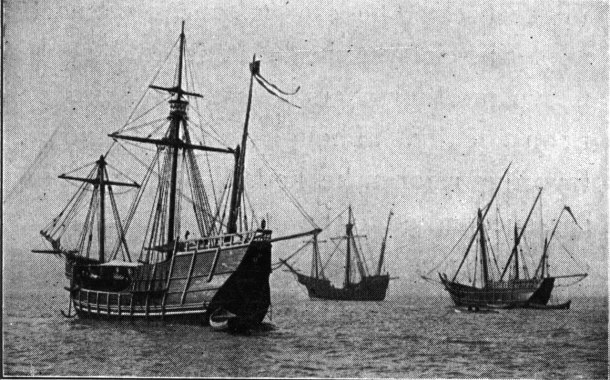
The situation gets more complicated with the other two ships. La Pinta was a
caravel-type vessel, smaller than the Santa Maria. The name Pinta is actually
the nickname given to it by its crew. It means Painted. Pinta was the fastest
ship in the expedition's fleet, and it seems her actual name disappeared off the
pages of history just as fast. Last, La Nina was also a caravel-type ship. Her
actual name is known. Like the Santa Maria and other Spanish ships, she was
traditionally named after a saint, in this case, Santa Clara.
12) Columbus Never Set Foot in North America
While the popularity of Columbus in the United States of America might make
you think otherwise, the Italian explorer never once set foot on the North
American continent. None of his four voyages took him even remotely close to the
eastern seaboard nor to what is now known as the state of Florida. His first
voyage, one that determined subsequent destinations, took him to what is known now
the Bahamas. The exact island he arrived at is unknown, with likely candidates
being San Salvador Island, Samana Cay, and the Plana Cays.
Map Outlining Columbus's Four Voyages to the New World
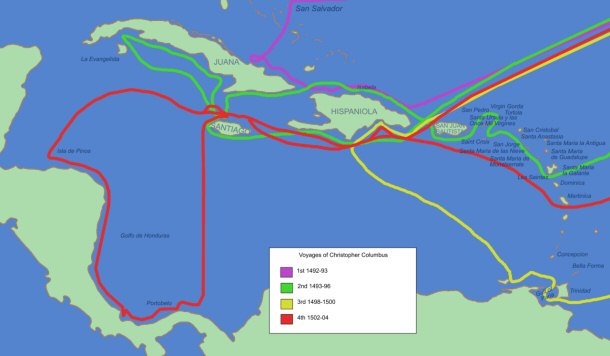
By Roke
via Wikimedia Commons
His exploration of the newly discovered region took him to the northern coast
of Cuba and then to the northern coast of Hispaniola. His final stop was the Bay
of Rincon in the Dominican Republic. During later voyages Columbus further
explored the region, visiting the northern shores of the South American
continent (the third voyage), and the shores of Central America (his fourth and
last voyage). Of course, additional voyages were not just exploratory in nature,
but were meant to establish permanent colonies on the coasts and to set up
missions to spread Christianity among the natives.
11) He Never Acknowledged He Discovered a New Land
One of the most interesting facts is that despite his accomplishments (after
all, a new continent isn't discovered every day), Columbus never acknowledged
that the islands and landmass he discovered actually formed a new continent. He
was convinced, until his death, that he did, indeed, discover the West Indies.
More interestingly, when he came upon South Africa and the delta of the Orinoco
River, he was convinced that he had discovered the Garden of Eden, once lost
biblically in
Christendom.
Columbus's Map Circa 1490
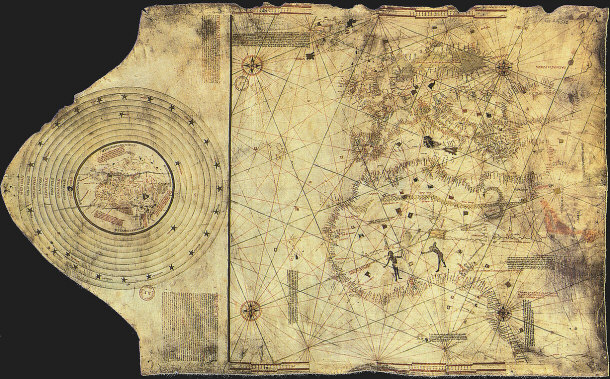
Columbus' persistence did not manage to get in the way of the facts.
Spearheaded by cartographer Amerigo Vespucci, the theory that the discovered
islands and landmass belonged to an entirely new continent became increasingly
popular, until it was finally accepted at the navigators conference in Toro in
1505, and in Burgos in 1508. After reviewing all the materials gathered on the
New World, the cartographers and navigators came to the only logical conclusion.
They concluded that Columbus had in fact discovered something, except it wasn't the West
Indies but a completely new continent. The first map to represent the Americas
as a separate landmass, the German Waldseemuller map, used Amerigo's name as its
source for christening the new continent. Understandably, Spain resisted this
new name, insisting that Columbus get the credit, not Amerigo. It took two
centuries for the Spanish Kingdom to cave in.
10) Columbus' Descendants Sued the Spanish Crown
This isn't the only notable posthumous fact about Columbus. Another is that,
stemming from his original agreement with the Spanish Crown as to the
expedition, Columbus was convinced that the Crown owed him 10 percent of the
entire commercial revenue generated by the colonies set up in the New World.
This amounted to an astronomical amount, resulting in the Crown looking for a
convenient excuse to deny Columbus the stipulated benefits. The explorer
provided one himself when he was relieved of his governorship of the New World.
As the contract depended on Columbus being a governor, the Spanish crown simply
considered the agreement to be null and void.
Columbus Being Greeted by King Ferdinand and Queen Isabella
on his Return to Spain
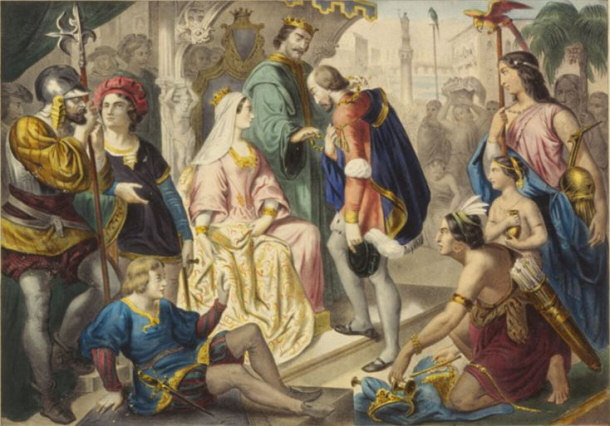
Understandably, Columbus was none too pleased about this, and fought
vigorously to obtain what he thought was rightfully his. The legal battle
survived him and continued for centuries, ending in the 18th century. The
pleitos colombinos (Colombian lawsuits) primarily took place between 1508 and
1536. Subsequent centuries saw occasional attempts to obtain a favorable ruling,
but they were universally unsuccessful. An interesting side-effect of this
protracted litigation was the creation of an extensive archive of knowledge
relating to the settlement of the New World, as the family and the Crown called
witnesses to testify from among the colonists.
9) His Resting Place was Disputed
Another interesting posthumous fact is that the remains of Christopher
Columbus have a rather storied history. Originally interred at Valladolid, his
body was then moved to a monastery in Seville, based on the will of Columbus'
son, Diego, the governor of Hispaniola. Then, circa 1542, his body was removed
from Seville and transported to Santo Domingo (Dominican Republic), where it
remained until the end of the 18th century with the French takeover of
Hispaniola. In response, Columbus' mortal remains were moved to Havana, Cuba.
Then, they were moved again, this time returning to Spain in the wake of the
Spanish-American War of 1898.
Tomb Of Christopher Columbus - Cathedral of Seville
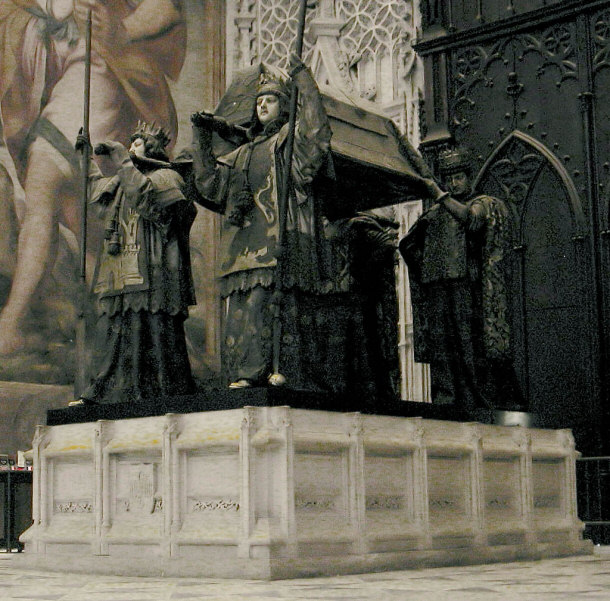
By Montrealais
via Wikimedia Commons
Problems appeared when a lead box marked Don Christopher Columbus was
recovered in Santo Domingo circa 1877. Containing fragments of bone and a musket
bullet, these were considered by some to be the true remains of Columbus and
were interred as such in Santo Domingo. The problem was resolved (though not
completely) in the 21st century, when DNA testing, supported by anthropologic
and historical analysis, concluded that the correct bones were moved to Seville.
Of course, since Dominican authorities never exhumed the remains claimed to
belong to Columbus nor determined the age of the bones, DNA testing did not
yield 100 percent accurate results.
8) No Actual Portrait of Him Exists
A simple answer to the above-mentioned problem would be to take Columbus'
skull, perform digital reconstruction, and compare it against surviving
portraits of the explorer. Although logical, this procedure rests on the
assumption: that such portraits exist. Although many are in circulation, there
is no genuine contemporary portrait of Christopher Columbus. As such, his exact
appearance is lost to time. Even artworks closest to the period when Columbus
lived were made several years after his death. Perhaps the most well-known is
Alejo Fernandez's altarpiece, The Virgin of the Navigators, painted between 1530
and 1536, commissioned for a chapel in Seville. It depicts Columbus in the crowd
of navigators, but the accuracy of the painting is unknown.
Engraving of Christopher Columbus- Notice the Variation
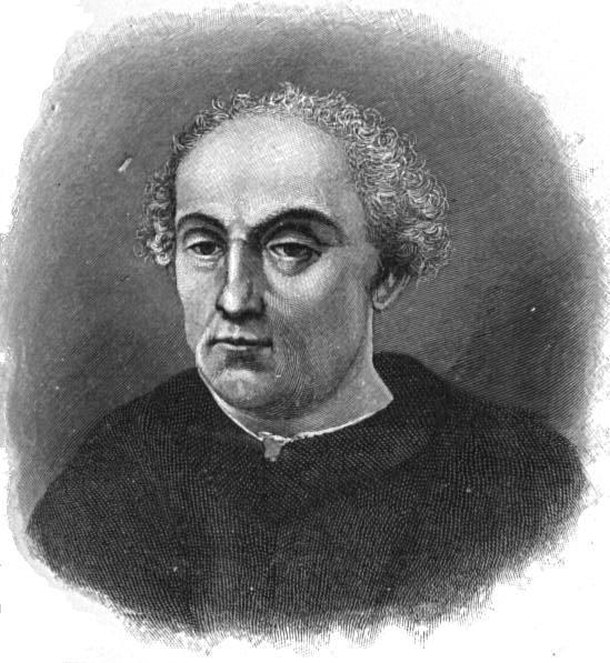
The most commonly reproduced portrait of Columbus is a 1519 painting by
Sebastiano del Piombo. Of note is the fact that unlike many later portraits,
including those circulated as part of the 1893 World's Columbian Exposition, it
remains true to descriptions of Columbus available from contemporary written
sources. Columbus was a tall, powerfully built man of imposing stature, not, as
some would have it, the stereotypical frail genius.
7) Genius or Not, He Had Bad Luck
Of course, every legend is idealized and most common portrayals of Columbus
show him as nothing short of a world-class hero. The reality is a little more
complex and decidedly bleaker. For starters, Columbus didn't have a perfect run
of luck throughout his voyages. In fact, on the very first expedition, he lost
his best ship, the Santa Maria, in a completely avoidable incident.
Recreation of Santa Maria
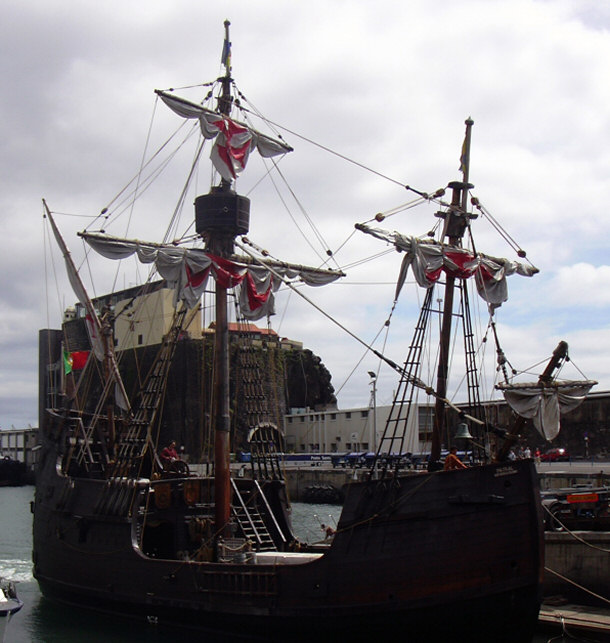
By Dietrich Bartel (my father) (Own work) [CC-BY-SA-2.0],
via Wikimedia Commons
The incident occurred when, after a night of heavy drinking and celebrating
their arrival in the West Indies (or so they thought), Columbus insisted on
sailing to Cuba through the night. As everyone knows, drunk driving is
dangerous. Drunk piloting of a ship weighing more than a hundred tons is an even
worse idea. The end result is that the crew, tired from all the drinking and
celebrating, fell asleep one by one, until the ship, piloted by a single cabin
boy, ran aground near what is now known as Cap-Haitien, Haiti, on December 25th,
1492. His run of luck also included surviving a terrible storm on his fourth
voyage and ending up stranded on the island of Jamaica due to damage incurred
during the storm.
6) Columbus Wasn't Nice
Bad luck aside, Christopher Columbus wasn't a particularly pleasant person.
One of the most interesting anecdotes, though definitely not amusing to the
person on the receiving end, concerns the discovery of the New World. The
Spanish rulers funding the expedition promised a lifetime pension to the person
who first saw land on the expedition. As this effectively amounted to living in
splendor for the rest of your life, everyone in the crew had a keen interest in
seeing land first.
Monument of Columbus
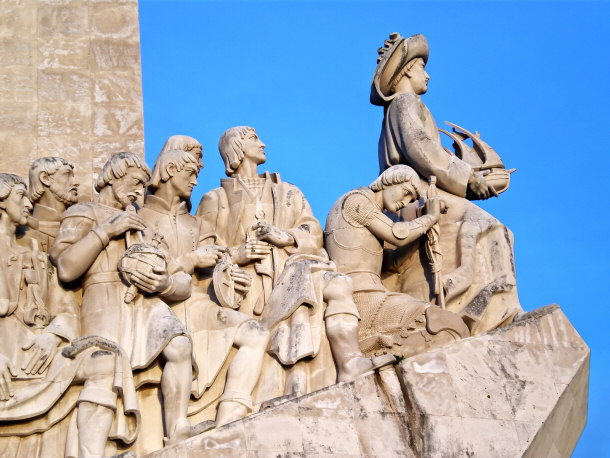
The first, was a sailor on the Pinta. Rodrigo de Triana spotted land around 2
a.m. on October 12th. After verifying the discovery, the Pinta's captain alerted
the flagship. Whatever Triana felt when he saw land, it gave way to bitter
disappointment when Columbus claimed that he already saw light on the land just
a few hours earlier. Nobody disputed the expedition leader's claims, and so
Columbus secured a lifetime pension for himself without any effort.
5) In General, He Was a Pretty Nasty Governor
Whatever qualities Columbus possessed as an explorer didn't apply to his
talents as a governor. As the man in charge of the Spanish colonies in the new
world, he revealed himself to be a thoroughly unpleasant person instituting a
rule best described as tyrannical. During the seven years Columbus and his
brothers governed, they treated the colonies like personal kingdoms, imposing
harsh regulations and executing the citizenry without regard for mercy.
Christopher Columbus Arrives in America
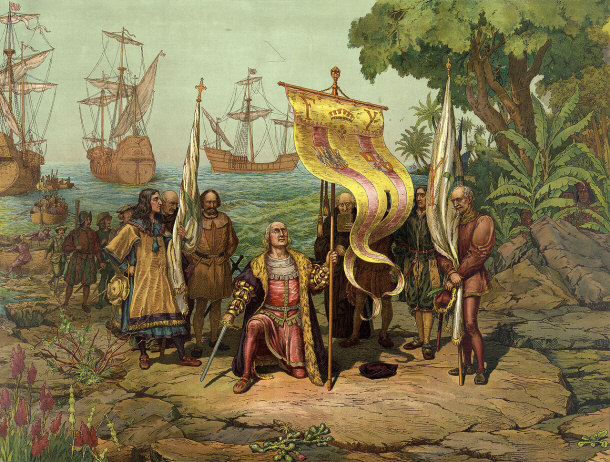
One example cited by a report from the colonies mentions that Columbus
employed torture and mutilation to maintain control. An investigation conducted
by Columbus' replacement, de Bobadila, cited several examples of brutality. For
example, stealing corn was punished by cropping the thief's ears and nose,
followed by selling him into slavery. A more gruesome example occurred when a
woman mentioned that Columbus came from the lower strata of society. What was the result?
Columbus forced her to walk naked through the streets of the colony, and then
ordered her tongue to be cut out. Ouch!
4) His Own Men Retaliated Against Him
As a result, the Spanish colonists and sailors intensely lobbied in the royal
court against Columbus, requesting that he and his brothers be replaced on
charges of mismanagement. Their resentment culminated in open rebellion in the
colonies when Columbus returned from his expedition to the northern shores of
the South American continent, where he scouted the Orinoco River. The colonists
felt cheated and worse, abused by Columbus and his family. Columbus retaliated
by hanging rebellious crewmen. Such extreme measures did nothing to help the situation,
but on the
contrary it only worsened things.
Columbus Before the Queen - Painting By Emanuel Gottlieb
Leutze - Oil on Canvas 1843
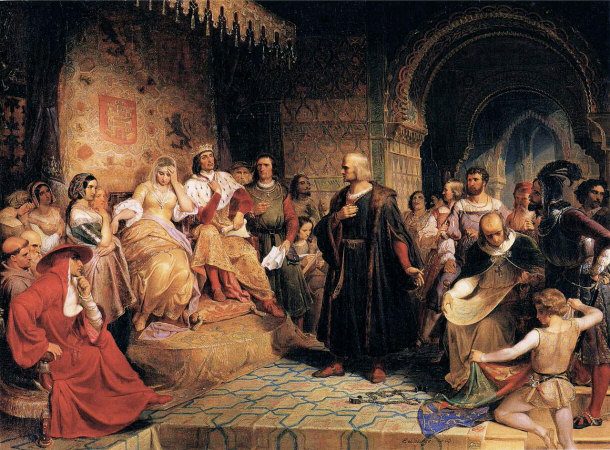
Columbus was forced to agree to the terms set forward by the colonists.
However, he was truly humiliated when the Spanish Crown ordered him to be
removed as governor, arrested, and returned to Spain. One would expect for him
to be publicly tried and punished for his mismanagement of the colonies, but
reality doesn't always work in a logical way. Columbus and his brothers were
pardoned by the King, their riches restored, and Columbus was even permitted to
lead a fourth expedition to the New World, but, thankfully, not as a governor.
3) Native Americans Really Don't Like Columbus
Columbus’ accomplishments resulted in him being elevated to near sainthood in
modern culture, particularly in the United States. The personification of the
United States is named Columbia, as is the district the nation's capital is
located in. The veneration of Columbus exploded following the American
Revolutionary War and persists to this day. However, it has to be noted that
this is a sentiment limited to people descended from immigrants and colonists.
The opinion of Native Americans is a lot harsher and less forgiving of the
explorer.
Landing of Columbus - Showing Objects to Native Americans
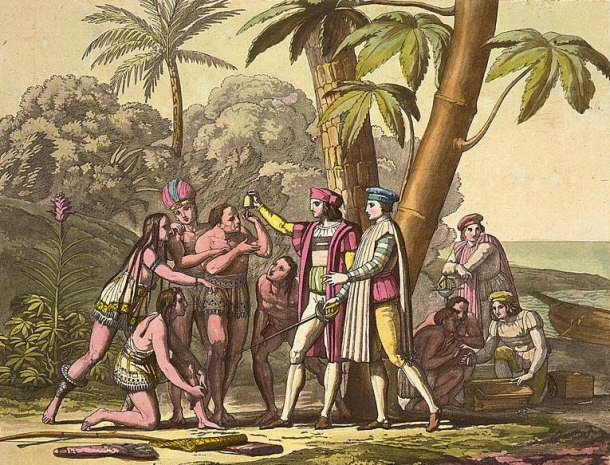
It is not without reason. The age of colonialism started by Columbus led to
massive changes for the indigenous peoples of the American continent, almost
never for the better. The critical opinion is grounded in the numerous adverse
events that followed in the wake of European colonization. Perhaps the most
striking of these were pandemics, where diseases commonly resisted in Europe
were introduced to a population that never had the opportunity to develop an
immunity to them, most notably devastating the empires established by the Aztecs
and the Inca. And, of course, there's the issue of abuse suffered by the
indigenous peoples at the hands of the colonists, Columbus included.
2) And They Have Good Reasons for It
Whatever transgressions Columbus perpetrated against colonists and crewmen he
led in the New World, they pale in comparison with what was done to the natives
under his administration. Native unrest and revolt was countered with brutal
retaliatory campaigns, which sometimes culminated in the dismembered bodies of
the natives being paraded through the streets to throttle attempts at rebellion.
In another instance, responding to a native attack on the colony of La Navidad
erected at the spot the Santa Maria was shipwrecked, Columbus demanded large
quantities of gold dust or spun wool as reparation, to be delivered every
several weeks. In case the demand was not delivered, Columbus' men would cut off
the hands of the natives and leave them to bleed out.
Columbus Landing on Hispaniola and Greeted by Arawak
Islands on December 6, 1492
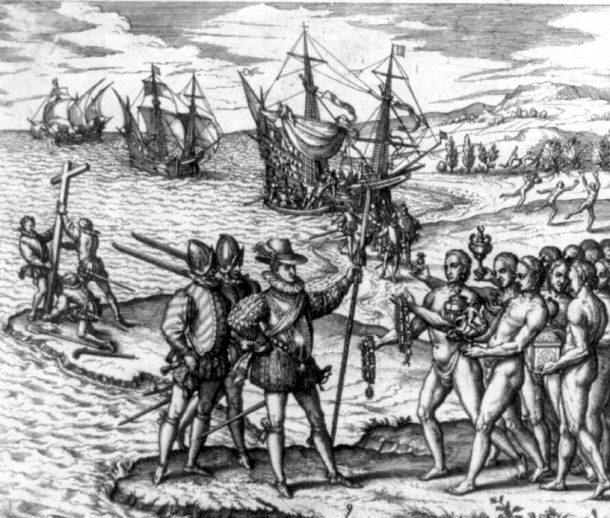
However, the most horrifying example of Columbus mistreating the
indigenous people is given by Bartolome de las Casas, who describes how the
mild-mannered, gentle inhabitants of Hispaniola were nearly totally
exterminated. In order to please the Spanish rulers, Columbus forced the natives
into a system of forced labor, herding them into mining and farming camps. They
were then forced to work until they died. As Casas observed, this reduced the
population of the island from millions to thousands in slightly over a decade.
The worst part? Columbus wouldn’t be the last to abuse the natives in such a
way. Subsequent governors would continue to misuse the indigenous populations of
the colonies, with perhaps the most horrific examples being the conquests of the
Spanish conquistadors; all done in pursuit of gold and glory.
1) He Certainly Wasn't the First to Discover the Americas
|
Eric the Red - Known for Founding
Greenland:
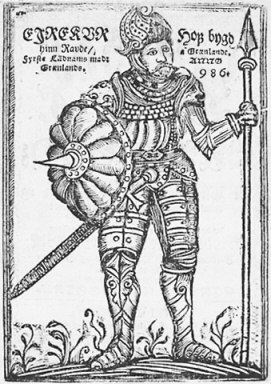
|
Perhaps the most interesting fact is that Christopher Columbus
wasn't the first European to discover the Americas. This credit goes to the
Norse explorers that settled Greenland around the 10th century. The Norse
explorers slowly started migrating westward, and eventually discovered the North
American continent. These early explorers formed small settlements meant to
exploit the local resources, such as timber and fur, as well as trade with the
indigenous peoples. The exact extent of Norse colonization of the North American
continent is a debatable issue, since no permanent colonies were established.
Most famous of the Norse explorers was a Viking explorer known as Erik
Thorvaldsson, or commonly known as Erik the Red.
Numerous factors were proposed to explain this phenomenon, many including the
hostility of the natives. Regardless, Norse explorers are known to have reached
the continent, with perhaps the most famous being Leif Erikkson, who explored
Vinland (the Norse name for North America) in detail after hearing of the
travels of Bjarni Herjolfsson. Finally, in spite of the ultimate failure of the
effort, the Norse voyages to North America remain chronologically the earliest
known exploration of the continent by Europeans.
Final Thoughts
As is true of all influential people in history, Columbus is a complex
person who has been left to the interpretation of time, and historical accounts
that many famous figures of history are subjected to. A great accomplished explorer that opened the Americas for colonization,
he unlocked a new chapter in history, traditionally accepted at the end of the
Middle Ages and the beginning of the Renaissance. At the same time his conduct
in the Americas, especially toward the indigenous peoples, is criminal at best,
and permanently damning at the extreme end of the moral spectrum. Even accounting for the differences in
morality and approach to the value of human life, it is difficult to excuse
activities that would now be described as genocide. Yet for all the horrors of
the Spanish colonization, it provided an impulse that would ultimately transform
Europe and open a new chapter in the history of the world.
Specific People
15 Things You Should Know About Stephen Hawking
15 Fascinating Facts about Michael Jackson
15 Fascinating Facts about Al Capone
15 Interesting Facts about Mother Teresa
15 Interesting Facts about Walt Disney
15 Interesting Facts about George Washington
15 Interesting Facts about Gandhi
15 Interesting Facts about Franklin Roosevelt
15 Interesting Facts about Ben Franklin
Top 15 Interesting Facts about Archimedes
15 Little Known Facts about Martin Luther King
15 Interesting Facts about Ronald Reagan
15 Interesting Facts about Nelson Mandela
15 Interesting Facts About Shakespeare
15 Interesting Facts about Marie Curie
15 Interesting Facts About Julius Caesar
15 Interesting Facts about Leonardo Da Vinci
15 Interesting Facts about Captain James Cook
15 Interesting Facts about John F. Kennedy
15 Interesting Facts About Cleopatra
15 Interesting Facts about Barack Obama
15 Interesting Facts About Albert Einstein
15 Interesting Facts about Adolf Hitler
15 Interesting Facts about Christopher Columbus
15 Interesting Facts About Bill Gates
People Related
15 Most Bizarre Things Purchased by Celebrities
Top 15 Reasons Why People Commit Suicide
25 Individuals Who Thrived with Savant Syndrome
20 Celebrities Who Invented Amazing Things
Top 15 Drugs People Commonly Overdose and Die From
Top 15 Myths about Death
15 Unusual Ways People Have Died
15 Crazy Festivities Around the World
55 Celebrities With Physical Imperfections
15 Funny and Unusual Ways Interviews Have Been Held
15 Weird Ways People Improve Their Confidence
15 Of the Darkest Crime Personalities We Hope to Never Meet
15 People Who Killed for a Living
15 Famous Celebrity Meltdowns
14 Fun Activities That Have Ended Up In Death
15 Facts & Info About Human Trafficking
Shorter Top Lists:
10 Billionaires as Wasteful or Fanciful as They are Wealthy
10 Ruthless Serial Killers Who Were Never Caught
10 Dangerous Serial Killers
Informational:
Detecting Lies: How to Tell Whether or Not Some is Truthful
Cannibalism in History and the Modern World
What Your Favorite Color Reveals About You
What is a Weirdo? Defining Weirdness in Society
Media's Effect on Society
How to Attract Beautiful Women |